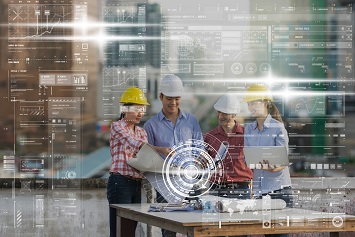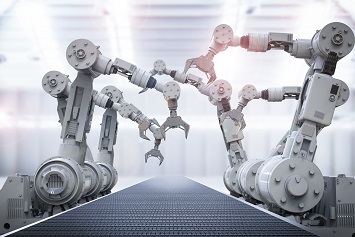Are you ready for the demographic, economic, and technological realities of the future of work? Benefits and challenges involving work, the workforce, and the workplace are coming, and now is the time to prepare.
There is renewed interest in researching and developing interventions for the future of work. The National Institute for Occupational Safety and Health (NIOSH) recently released what it calls its “foundational paper” in the American Journal of Industrial Medicine on future-of-work issues and approaches to addressing them.
You may already be seeing changes in demographics, organizational design, and work arrangements, especially as many job functions have become and remain remote in the midst of the coronavirus disease 2019 (COVID-19) pandemic. Technologies, including artificial intelligence (AI) and robotics, may displace some workers but require others to pick up new skills to take on new roles.
NIOSH’s research may be looking into issues that may not directly affect your day-to-day operations—issues like technological job displacement and job insecurity. Occupational safety and health (OSH) and industrial hygiene researchers have long been interested in issues that directly affect worker well-being, like income security, access to health insurance, work/life or work/family balance, and paid time off.
If the future of work exacerbates issues surrounding work arrangements; economic security; work/family balance; and the overall safety, health, and well-being of the workforce, it may result in a push for new legislation, regulation, or taxes.
Future of Work Initiative
NIOSH launched its Future of Work Initiative in 2019, applying its Total Worker Health (TWH) approach to emerging and growing workplace safety and health issues. NIOSH has funded or directed multidisciplinary research and communications, and it has formed partnerships throughout the institute and with other government agencies and organizations to identify research opportunities and practical approaches to addressing the future of work.
NIOSH has chosen to develop its futures-oriented capacity, prioritizing research into possible scenarios, planning to shape the future of work by helping stakeholders anticipate those possible scenarios and their impact, and offering recommendations for handling those scenarios.
Issues beginning to affect work, the workforce, and the workplace include the availability or lack of resources, changing demographics, disaster and emergency preparedness and response, extreme weather conditions, globalization, new exposures and hazards, politics and policies, and social disruption, along with the automation and technologies of the fourth Industrial Revolution (Industry 4.0), which range from AI and machine learning (ML) to robotics, advanced manufacturing techniques, the Internet of Things, and sensor technology.
Along with other OSH stakeholders, NIOSH hopes to understand the implications of future-of-work scenarios and translate effective interventions into practice for employers looking to safeguard the safety, health, and well-being of their workforce.
Opportunities, Threats of Technology
While certain technologies like sensors may help provide greater levels of safety, many “future of work” scenarios will demand greater employer attention to safety and health. NIOSH suggests employers may need to take a more integrated approach to workplace safety and health.
One sub-discipline of AI—ML—has led to applications like sensor technologies, robotic devices, and cognitive decision support systems that may be useful in safety and health management, as well as less relevant technologies like image and speech recognition and goods and services recommender systems on e-commerce sites.
Researchers at the University of Buffalo and Miami University of Ohio found that body sensors can help detect signs of fatigue and call attention to the need for interventions. Wearable sensors can detect the starting point of fatigue by monitoring body movements and then alerting workers and supervisors to the need to intervene before injuries can occur. The Center for Construction Research and Training (CPWR) has looked into the potential for wearable sensors to alert construction workers of nearby vehicles or equipment, preventing caught-between and struck-by injuries. Caught-between and struck-by hazards are two of the “fatal four” injury hazards, along with electrocution and falls.
Workplaces increasingly are seeing changes to the designs of organizations, such as fewer jobs with fixed schedules, dedicated locations, or employees under direct control of a single employer. Many jobs can be done from nearly anywhere at practically any time of day thanks to Wi-Fi-enabled laptops, smartphones, and tablets. Even before the pandemic, some 20% of U.S. workers engaged in remote or mobile work at least some of the time.
Perhaps as much as 37% of jobs in the United States could be performed completely at home, but the capabilities vary by geographic location, industry, and occupation.
However, home offices frequently are configured without employer guidance, and the unknown injury risks leave employers unsure of the workers’ compensation and legal implications of employee injuries. Employers typically provide ergonomically designed work spaces, personal protective equipment (PPE), and work equipment and tools at in-person workplaces.
New buildings and evolving workplaces also have offered employers opportunities to focus on employee wellness through smart ventilation and environmental controls, automated safety mechanisms and controls, green buildings, sit-stand and active workstations, nutritious food options, and access to on-site exercise facilities. The rising spread of work from home and other remote work denies employers those wellness opportunities.
Some research has found that jobs consisting primarily of remote work may blur the boundaries between work and personal life, increasing both work/family conflict and work-related stress. Nearly two-thirds of adults identify work as a significant source of stress, according to NIOSH.
Nonstandard Work Arrangements
More workers also are in nonstandard work arrangements, including independent contractors, on-call workers, temporary help agency workers, and workers provided by contract firms. Even permanent employees may perform other work outside a regular job, using app-enabled “gig” platforms. The challenge for employers is that they likely have no idea what other exposures and stresses are present in their employees’ lives. A NIOSH study found that some workers in nonstandard work arrangements, such as independent contractors, experienced increased job stress and self-reported an increased number of “unhealthy” days.
Nonstandard employment arrangements also interfere with the availability of employer-sponsored leave like paid vacation and sick, parental, and caregiving leave that traditionally has played a central role in employment relationships and employees’ work/life balance. Work/life interventions have been vital for worker well-being and have ranged from traditional approaches like supervisor training in family-friendly supervision, self-scheduling, and dependent care programs like on-site day care.
Nonstandard employment relationships can frustrate such practices.
Worker Displacement
Technological job displacement—when jobs or work tasks traditionally performed by human workers are replaced with technology through automation, digitization, and robotics—leads to the elimination of jobs, as some jobs become obsolete, fundamentally altering many occupations and even entire industries. While the full extent of job losses can be difficult to forecast, some studies have predicted that about half of all job tasks in the U.S. economy could be automated.
In the past, fundamental changes in work have been accompanied by new jobs created by new technologies and the emergence of new industries. Similarly, political reactions could curtail or stop productivity-enhancing technologies from being adopted if they would result in massive worker displacement. The threat of commercial motor vehicle and taxi drivers being displaced by fully autonomous vehicles (AVs) may not happen if there is no overall public acceptance of the technology, risk, and liability associated with AV use in transportation.
Researchers already are seeing adverse effects of technological displacement or even the perception of a future lacking in employment opportunity. Such perceptions can create anxiety in workers and can lead to an increase in depression, suicide, and alcohol and drug abuse, including opioid-related mortality.
The Robots Are Coming
The rise of robotics in the workplace holds tremendous potential to improve work, as well as pose a potential for harm to human workers in their interaction with robots. For example, workers can be physically injured from unexpected contact with robots. If workers temporarily lose their situational awareness, they may be unable to adequately react to hazards posed by robots, which has already happened in fatal crashes involving highly automated vehicles.
Examples of robotics in the workplace include:
- Service robots that perform specific tasks like cleaning public spaces; delivering items in hospitals and hotels; fighting fires; and performing inspections, maintenance, and repairs in confined spaces;
- Automated industrial vehicles like driverless forklifts and tractors and automated vehicles used to haul materials in mining that could one day be piloted for the transit of people and commercial goods delivery;
- Unmanned aerial vehicles (UAVs or drones) increasingly used to evaluate structures and worksites and may one day be used for the delivery of goods; and
- Wearable exoskeletons and exosuits designed to reduce stress on some body parts and augment human workers’ physical capacity.
However, along with the potential for harmful physical contact with robots, workers also may have concerns about job loss or displacement due to robots. If robots do displace workers, more displaced workers may find work in the “gig” economy, along with all the accompanying adverse effects of nonstandard work arrangements.
In addition to concerns about worker safety and well-being with the rise of AI and robotics, NIOSH and its research partners also are looking into other possible effects of Industry 4.0. These include new materials in additive manufacturing, also known as three-dimensional (3D) printing, and the development of biology-based processes to replace traditional manufacturing. Synthetic biology innovations could affect industries from forestry and farming to biofuels, genetics, and food production.
Some researchers have suggested that Industry 4.0 requires an “OSH 4.0” response—an expanded, more holistic, and multi-/transdisciplinary approach to confront complex and novel safety and concerns. One of those OSH 4.0 approaches may be the TWH approach—policies, programs, and practices that maintain the protection of workers from work-related safety and health hazards while promoting injury and illness prevention efforts to advance worker well-being.
While the future of work poses significant but not yet fully understood challenges, exposures, and hazards, it also presents many new opportunities for workplace, work, and workforce interventions. NIOSH and its OSH stakeholders are trying to prepare employers and workers for both challenges and opportunities by providing sound, evidence-based recommendations on how to best safeguard and promote the safety, health, and well-being of workers facing uncertain futures.



